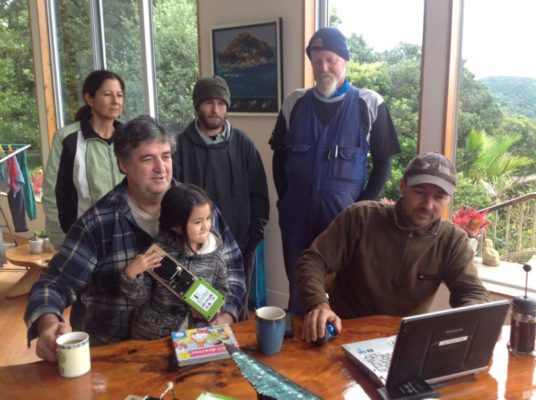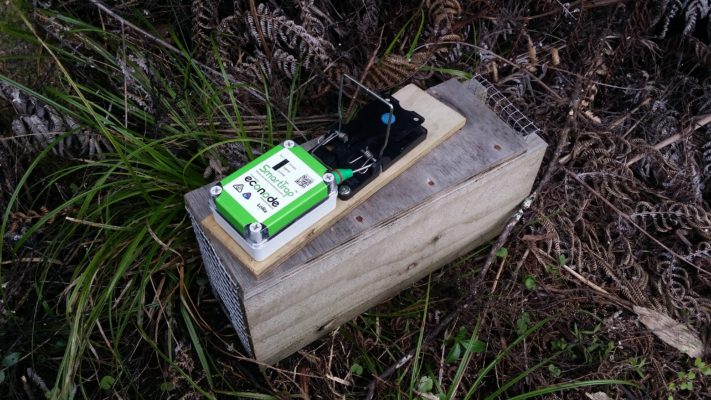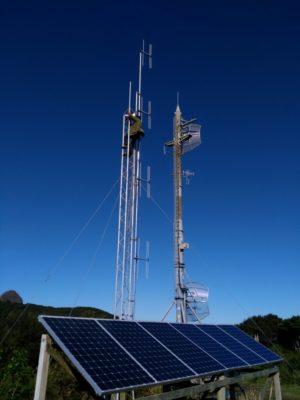Behind the doors of ordinary Kiwi garages, some astonishing things are happening. Take, for example, a garage somewhere in the suburbs of Upper Hutt, where a robot is currently assembling circuit boards for the Econode designed remote trap sensor devices.

Meanwhile, back at Econode ‘home base’ on Great Barrier Island, Matt Way is working in his own, solar-powered shed, designing the electronics and writing the software that will enable the “nodes” to electronically monitor each individual trap in a network using LoRa radio technology.
“The exciting thing about the LoRa standard is that it’s being deployed internationally as well as New Zealand,” Matt says.
Currently there are two providers of LoRa in New Zealand: KotahiNet & Spark NZ.
“The biggest challenge is the environment – keeping everything watertight,” says Matt. “The radio technology works well. Our new design has both the sensor and antenna internally mounted so we are very confident the nodes will stay dry in the harsh New Zealand bush.”
Like many examples of ‘kiwi ingenuity’, the innovative Econode project began when Matt and business partner Scott Sambell thought ‘there’s got to be a better way’ – in this case a better, more efficient way to check traps than tramping around looking at every single one. The SmartTrap device they came up with can be attached to most of the traps currently available, by attaching a magnet without any further modification needed. When a trap is sprung, a signal is sent to a base station (LoRa gateway) using the radio network, then uploaded to the internet.

“We didn’t want reinvent apps,” says Matt, “We worked with what was already available, so Econode can integrate with other systems such as Google apps, TrapNZ and ESRI/ArcGIS.”
Matt’s business partner Scott Sambell used to be the manager of the Glenfern Sanctuary on Great Barrier. But now works all over the country on biosecurity projects with everything from drones to dogs. (He was away in the Chathams with his rat-dog Milly, so wasn’t available to be interviewed.) Scott could see the value of a trap monitoring system. Matt had the electronic design and software writing skills to make it happen.
Matt and his family returned to New Zealand a few years ago, after living in Thailand, working for the oil and gas industry.
“With my daughter (who’s now 5), I wanted to get back to New Zealand and nature,” he says. “And I thought it’d be great to use my skills for conservation.”
It’s now about 3 years since the project started, with the Econode Ltd company formed two years ago and welcome financial support from the World Wide Fund for Nature (WWF) helping to get things rolling.
One of the early conservation projects to trial the Econode devices was good friend Judy Gilbert’s Windy Hill Sanctuary.
Mulberry Grove School on Great Barrier are also early SmartTrap users. The community have been trapping on the foreshore adjacent to the school for the last 10 years and for the last 12 months have had Econode SmartTrap devices attached to each of their 18 traps. The pupils aren’t just learning about conservation – maths and statistics skills are being put to practical use too.

Mulberry Grove pupils will soon be linking up to fellow Econode users at Orphir Community School in the Orkney Islands, Scotland where they are trapping stoats and minks. They’ll be comparing biodiversity and pest control programmes in their two communities.
“We are planning on working with Mulberry Grove school to create ‘Flipped Classroom’ video presentations to be made available to other schools”, says Matt. “The support and encouragement from the community, Local Board and DOC has been very encouraging, and goes to show what can be achieved at a local level.”
Matt and the Econode team are also in discussion with a conservation group in Cornwall UK an area where invasive grey squirrels are a pest issue, threatening the survival of native red squirrels.
“We’re hoping to export the technology,” Matt says. “There are 2 key things we need to do – SmartTrap needs to be very robust and we need to keep costs down. We’re really struggling with a lack of funding though,” he admits. “If we had more funding, we could make 1000 units per week instead of 100/week. With funding the units would be cheaper.”
“We are proud of the fact SmartTrap nodes are made in New Zealand, and with efficient micro manufacturing the costs are only marginally more than getting SmartTrap nodes made in China. Likewise we are keeping costs down by using open source software”
Recently Econode teamed up with another group of kiwi innovators, Paekakariki-based GroundTruth, the developers of the Trap.NZ website and free app for pest control project management.
“We believe in environment, community, collaboration and opensource /opendata,” Matt says.
The two companies have been collaborating for about a year now, working on a remote-monitoring project for the Kapiti Biodiversity Trust. It’s an exciting project – an offshore island standing sentinel over a 30 km coastal mainland trapping network.

